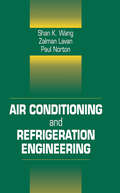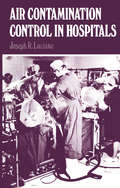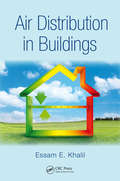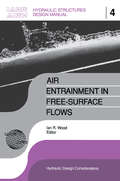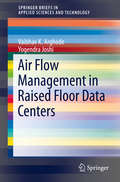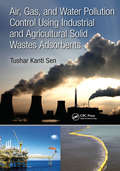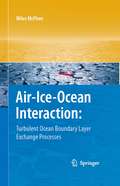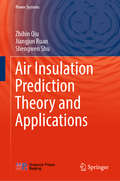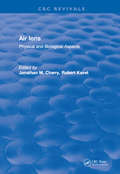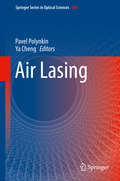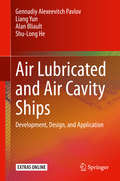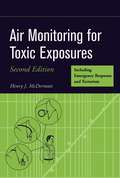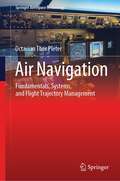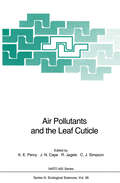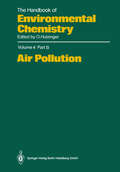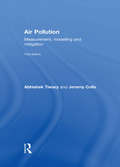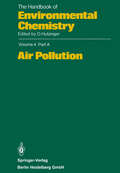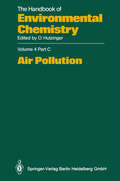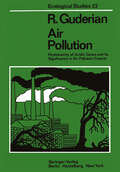- Table View
- List View
Air breathed in and air breathed out (UEB uncontracted)
by RnibThis page shows a diagram of an experiment about breath, demonstrating the difference between inhaled and exhaled air. There is a locator dot shown, which will be at the top left, when the image is the correct way up. There are two test tubes, one on the left and one on the right of the page. They are both configured the same way with a bung and two tubes. The tube on the left comes out and is bent to the left. The tube on the right comes out and is bent to the right. Both test tubes are half filled with limewater. The lime water on the left is clear and the limewater on the right is cloudy, a pale milky white. In the first test tube the inhaled air would create low pressure in the test tube which would suck air into the test tube from the atmosphere. This air would bubble through the limewater. Atmospheric air contains relatively low levels of carbon dioxide so the limewater stays relatively clear. In the second test tube the exhaled air bubbles through the limewater. Exhaled breath contains much more carbon dioxide so the limewater goes a cloudy, milky white.
Air Conditioning and Refrigeration Engineering
by Frank Kreith Shan K. Wang Paul NortonAn air conditioning system consists of components and equipment arranged in sequential order to control and maintain an indoor environment. The goal is to provide a healthy and comfortable climate with acceptable air quality while being energy efficient and cost effective. Air Conditioning and Refrigeration Engineering covers all types of systems from institutional and commercial to residential.The book supplies the basics of design, from selecting the optimum system and equipment to preparing the drawings and specifications. It discusses the four phases of preparing a project: gathering information, developing alternatives, evaluating alternatives, and selling the best solution. In addition, the author breaks down the responsibilities of the engineer, design documents, computer aided design, and government codes and standards.Air Conditioning and Refrigeration Engineering provides you with an easy reference to all aspects of the topic. This resource addresses the most current areas of interest, such as computer-aided design and drafting, desiccant air conditioning and energy conservation. It is a thorough and convenient guide to air conditioning and refrigeration engineering.
Air Conditioning and Refrigeration Engineering (Engineering Handbooks)
by Shan K. Wang, Zalman Lavan and Paul NortonAn air conditioning system consists of components and equipment arranged in sequential order to control and maintain an indoor environment. The goal is to provide a healthy and comfortable climate with acceptable air quality while being energy efficient and cost effective. Air Conditioning and Refrigeration Engineering covers all types of systems from institutional and commercial to residential.The book supplies the basics of design, from selecting the optimum system and equipment to preparing the drawings and specifications. It discusses the four phases of preparing a project: gathering information, developing alternatives, evaluating alternatives, and selling the best solution. In addition, the author breaks down the responsibilities of the engineer, design documents, computer aided design, and government codes and standards.Air Conditioning and Refrigeration Engineering provides you with an easy reference to all aspects of the topic. This resource addresses the most current areas of interest, such as computer-aided design and drafting, desiccant air conditioning and energy conservation. It is a thorough and convenient guide to air conditioning and refrigeration engineering.
Air Contamination Control in Hospitals
by J. LucianoThis is a well conceived and executed volume detailing in close to encyclopedic proportions the question of control of air borne contamination in hospital environments. Many different ap plication areas are described and well documented. Alternative solutions are presented in historical perspective with the neces sary scientific background to provide the uninitiated an oppor tunity to learn not only how to solve a particular problem but more critically why one solution is preferable to another. Every clinician concerned for his patients' welfare must consider the quality of the environment within the hospital--for only there is it potentially controllable Airborne dissemination of nosocomial infections are considered generally rare today. This may be the result of improved intrahospital environmental control or better infection control techniques. If one considers airborne contaminatiqn, real or potential, as undesirable within certain areas of a hospital then proper environmental control must be included in the framework of the physical and functional struc ture. Often it is difficult to specify which controls are needed for a specific application. Frequently this is a problem of in adequate knowledge of the application area and not the availability of technology. Too often, in the rush to provide a solution the newest and most sophisticated equipment is chosen, installed, and found to be more than is required for the task. To avoid these types of errors it is necessary to provide a series of alternative solutions for each problem.
Air Distribution in Buildings
by Essam E. KhalilAir Distribution in Buildings is a concise and practical guide to air distribution system design and managing air conditioning systems in buildings. Making use of 40 years of experience in the design of air conditioning and ventilations systems, and other electromechanical services, this structured reference for built environment engineering offers
Air Entrainment in Free-surface Flow: IAHR Hydraulic Structures Design Manuals 4
by I. R. WoodThis monograph is aimed at the practising hydraulic engineer. Work on it commenced at Professor Naudascher's instigation in 1982. Over the next six years all or some of the authors discussed progress at IAHR sponsored conferences at Esslingen, Melbourne, Lausanne and Beijing. With the authors scattered throughout the world, and all with other responsibilities, progress was bound to be slow. Completion was further delayed by the great increase in published technical literature in this area over the period 1982-1988. This literature continues to expand and with it our understanding of the air water flow phenomena. The monograph must therefore be seen as the authors' views on the state of the art around 1988. More recent references have been included for completeness.This monograph has been a joint effort with most authors making suggestions and contributions to more than one chapter. Nevertheless, the chapter authors are primarily responsible for the material in their chapters.Throughout the monograph symbols are defined when they are fist introduced and a list of symbols is included at the end of each chapter.Many other people have contributed to this monograph, but the authors would particularly like to acknowledge the assistance given by Professor John McNown who has read, commented on and improved the style of the complete monograph.
Air Entrainment in Free-surface Flow: IAHR Hydraulic Structures Design Manuals 4
by Ian R. WoodThis monograph is aimed at the practising hydraulic engineer. Work on it commenced at Professor Naudascher's instigation in 1982. Over the next six years all or some of the authors discussed progress at IAHR sponsored conferences at Esslingen, Melbourne, Lausanne and Beijing. With the authors scattered throughout the world, and all with other responsibilities, progress was bound to be slow. Completion was further delayed by the great increase in published technical literature in this area over the period 1982-1988. This literature continues to expand and with it our understanding of the air water flow phenomena. The monograph must therefore be seen as the authors' views on the state of the art around 1988. More recent references have been included for completeness.This monograph has been a joint effort with most authors making suggestions and contributions to more than one chapter. Nevertheless, the chapter authors are primarily responsible for the material in their chapters.Throughout the monograph symbols are defined when they are fist introduced and a list of symbols is included at the end of each chapter.Many other people have contributed to this monograph, but the authors would particularly like to acknowledge the assistance given by Professor John McNown who has read, commented on and improved the style of the complete monograph.
Air Flow Management in Raised Floor Data Centers (SpringerBriefs in Applied Sciences and Technology)
by Vaibhav K. Arghode Yogendra JoshiThe Brief discuss primarily two aspects of air flow management in raised floor data centers. Firstly, cooling air delivery through perforated tiles will be examined and influence of the tile geometry on flow field development and hot air entrainment above perforated tiles will be discussed. Secondly, the use of cold aisle containment to physically separate hot and cold regions, and minimize hot and cold air mixing will be presented. Both experimental investigations and computational efforts are discussed and development of computational fluid dynamics (CFD) based models for simulating air flow in data centers is included. In addition, metrology tools for facility scale air velocity and temperature measurement, and air flow rate measurement through perforated floor tiles and server racks are examined and the authors present thermodynamics-based models to gauge the effectiveness and importance of air flow management schemes in data centers.
Air, Gas, and Water Pollution Control Using Industrial and Agricultural Solid Wastes Adsorbents
by Tushar Kanti SenAir and water pollution occurs when toxic pollutants of varying kinds (organic, inorganic, radioactive and so on) are directly or indirectly discharged into the environment without adequate treatment to remove these potential pollutants. There are a total of 13 book chapters in three sections contributed by significant number of expert authors around the world, aiming to provide scientific knowledge and up-to-date development of various solid wastes based cost-effective adsorbent materials and its sustainable application in the removal of contaminates/pollutants from air, gas and water. This book is useful for the professions, practicing engineers, scientists, researchers, academics and undergraduate and post-graduate students’ interest on this specific area. Key Features: • Exclusive compilation of information on use of industrial and agricultural waste based adsorbents for air and water pollution abatement. • Explores utilization of industrial solid wastes in adsorptive purification and agricultural and agricultural by-products in separation and purification. • Discusses cost-effective solid wastes based emerging adsorbents. • Alternative adsorbents in the removal of a wide range of contaminants and pollutants from water is proposed. • Includes performance of unit operations in waste effluents treatment.
Air, Gas, and Water Pollution Control Using Industrial and Agricultural Solid Wastes Adsorbents
by Tushar Kanti SenAir and water pollution occurs when toxic pollutants of varying kinds (organic, inorganic, radioactive and so on) are directly or indirectly discharged into the environment without adequate treatment to remove these potential pollutants. There are a total of 13 book chapters in three sections contributed by significant number of expert authors around the world, aiming to provide scientific knowledge and up-to-date development of various solid wastes based cost-effective adsorbent materials and its sustainable application in the removal of contaminates/pollutants from air, gas and water. This book is useful for the professions, practicing engineers, scientists, researchers, academics and undergraduate and post-graduate students’ interest on this specific area. Key Features: • Exclusive compilation of information on use of industrial and agricultural waste based adsorbents for air and water pollution abatement. • Explores utilization of industrial solid wastes in adsorptive purification and agricultural and agricultural by-products in separation and purification. • Discusses cost-effective solid wastes based emerging adsorbents. • Alternative adsorbents in the removal of a wide range of contaminants and pollutants from water is proposed. • Includes performance of unit operations in waste effluents treatment.
Air-Ice-Ocean Interaction: Turbulent Ocean Boundary Layer Exchange Processes
by Miles McPheeAt a time when the polar regions are undergoing rapid and unprecedented change, understanding exchanges of momentum, heat and salt at the ice-ocean interface is critical for realistically predicting the future state of sea ice. By offering a measurement platform largely unaffected by surface waves, drifting sea ice provides a unique laboratory for studying aspects of geophysical boundary layer flows that are extremely difficult to measure elsewhere. This book draws on both extensive observations and theoretical principles to develop a concise description of the impact of stress, rotation, and buoyancy on the turbulence scales that control exchanges between the atmosphere and underlying ocean when sea ice is present. Several interesting and unique observational data sets are used to illustrate different aspects of ice-ocean interaction ranging from the impact of salt on melting in the Greenland Sea marginal ice zone, to how nonlinearities in the equation of state for seawater affect mixing in the Weddell Sea. The book’s content, developed from a series of lectures, may be appropriate additional material for upper-level undergraduates and first-year graduate students studying the geophysics of sea ice and planetary boundary layers.
Air Insulation Prediction Theory and Applications (Power Systems)
by Zhibin Qiu Jiangjun Ruan Shengwen ShuThis book proposes the air insulation prediction theory and method in the subject of electrical engineering. Prediction of discharge voltage in different cases are discussed and worked out by simulation. After decades, now bottlenecks of traditional air discharge theories can be solved with this book. Engineering applications of the theory in air gap discharge voltage prediction are introduced. This book serves as reference for graduate students, scientific research personnel and engineering staff in the related fields.
Air Ions: Physical and Biological Aspects
by Jonathan M. CharryAir Ions: Physical and Biological Aspects fully develops two areas that are important for a comprehensive understanding of the subject of air ions: (1) the physical/chemical nature of ions, and (2) their potential interaction with biological systems. The reader is led through a series of none chapter, the first five of which lay the basis for understanding ions in the context of naturally and artificially created environments. The final four chapters are well situated to discuss the literature and history connected with the search for ion-induced biological effects.
Air Ions: Physical and Biological Aspects
by Jonathan M. CharryAir Ions: Physical and Biological Aspects fully develops two areas that are important for a comprehensive understanding of the subject of air ions: (1) the physical/chemical nature of ions, and (2) their potential interaction with biological systems. The reader is led through a series of none chapter, the first five of which lay the basis for understanding ions in the context of naturally and artificially created environments. The final four chapters are well situated to discuss the literature and history connected with the search for ion-induced biological effects.
Air Lasing (Springer Series in Optical Sciences #208)
by Pavel Polynkin Ya ChengThis book presents the first comprehensive, interdisciplinary review of the rapidly developing field of air lasing. In most applications of lasers, such as cutting and engraving, the laser source is brought to the point of service where the laser beam is needed to perform its function. However, in some important applications such as remote atmospheric sensing, placing the laser at a convenient location is not an option. Current sensing schemes rely on the detection of weak backscattering of ground-based, forward-propagating optical probes, and possess limited sensitivity. The concept of air lasing (or atmospheric lasing) relies on the idea that the constituents of the air itself can be used as an active laser medium, creating a backward-propagating, impulsive, laser-like radiation emanating from a remote location in the atmosphere. This book provides important insights into the current state of development of air lasing and its applications.
Air Lubricated and Air Cavity Ships: Development, Design, and Application
by Alan Bliault Liang Yun Gennadiy Alexeevitch Pavlov Shu-Long HeAir Lubrication and Air Cavity Technology is a major development that has emerged in recent years as a means to reduce resistance and powering for many types of ships, and an efficient design for high speed marine vessels. This book introduces the mechanisms for boundary layer drag reduction and concepts studied in early research work. Air bubble and sheet lubrication for displacement vessels is outlined and the key projects introduced. Generation of low volume flow air cavities under the hull of displacement, semi displacement and planing vessels are introduced together with theoretical and empirical analysis and design methods. Resistance reduction, power reduction and fuel efficiency are covered for both displacement and high speed vessels. Air layer and air cavity effects on vessel static and dynamic stability are covered, linked to regulatory requirements such as IMO. Seaway motions and reduced impact load of high speed craft in waves are discussed including model test results. Integration of propulsion systems for optimum powering is summarized. A design proposal for a wave piercing air cavity craft is included in an appendix. A comprehensive listing of document resources and internet locations is provided for further research.
Air Monitoring for Toxic Exposures
by Henry J. McDermottGet the Latest from the Field This book offers ready-to-use information for measuring a wide variety of airborne hazardous materials including chemicals, radon, and bioaerosols. It provides the latest procedures for air sampling, collecting biological and bulk samples, evaluating dermal exposures, and determining the advantages and limitations of a given air monitoring method.
Air Navigation: Fundamentals, Systems, and Flight Trajectory Management (Springer Aerospace Technology)
by Octavian Thor PleterThis book takes a new approach to air navigation, extending the classic scope of positioning and guidance to efficient and safe 4D flight trajectory management. Modern air navigation aims at flight trajectories optimisation. There is an infinite number of solutions to the classic navigation problem of flying from one airport to another, but most of them are wasteful of resources and even risky. Minimising all costs and risks incurred by the 4D flight trajectory makes air navigation both efficient and safe, which are key factors in air navigation services. Beyond minimising fuel burn and CO2, efficiency addresses non-CO2 emissions and noise. This is a visually intensive book, using examples and case studies to illustrate the concepts, the physics of navigation and the mathematical models involved. Numerical examples reflect its problem-solving nature. It is useful to aerospace students, engineers, pilots, air traffic controllers, technicians, and scientists curious about aviation.
Air Pollutants and the Leaf Cuticle (Nato ASI Subseries G: #36)
by Kevin E. Percy J. Neil Cape Richard Jagels Caroline J. SimpsonPlant leaves are covered by a thin, lipoidal, non-living membrane called the cuticle. Forming the interface between plants and the atmospheric environment, it presents an effective barrier to pollutant entry. The book provides a comprehensive review of air pollutant effects on the cuticle and covers the following thematic areas: - Cuticular physicochemical characteristics, physiological, regulatory, and protective roles. - Effects, mechanisms, and consequences of air pollutant interaction with leaf cuticles. - Non-anthropogenic and environmental influences on the cuticle and potential of the cuticle for biomonitoring and critical levels mapping. - New developments in experimental methodology and analytical techniques.
Air Pollution (The Handbook of Environmental Chemistry #4 / 4B)
by H. Brauer J. S. Gaffney R. Harkov M.A.K. Khalil F. W. Lipfert N. A. Marley E. W. Prestbo G. E. ShawAn important purpose of The Handbook of Environmental Chemistry is to aid the understanding of distribution and chemical reaction processes which occur in the environment. Volume 4, Part B of this series is dedicated to Air Pollution Control Equipment, Materials Damage, Peroxyacyl Nitrates, Semivolatile Compounds in the Atmosphere, and Arctic Haze.
Air Pollution: Measurement, Modelling and Mitigation, Third Edition
by Jeremy Colls Abhishek TiwaryA one stop, comprehensive textbook, covering the three essential components of air pollution science. The Third Edition has been updated with the latest developments, especially the inclusion of new information on the role of air pollutants in climate change. The authors give greater coverage to the developing economies around the world where air pollution problems are on the rise. The Third Edition continues to cover a wide range of air quality issues, retaining a quantitative perspective. Topics covered include - gaseous and particulate air pollutants, measurement techniques, meteorology and dispersion modelling, mobile sources, indoor air, effects on plants, materials, humans and animals. Moving away from classical toxic air pollutants, there is a chapter on climate change and another on the depletion of stratospheric ozone. A special feature of this new edition is the inclusion of a fresh chapter on air pollution mitigation by vegetation, mainly its role in maintaining a sustainable urban environment. Recommended for upper-level undergraduate and postgraduate courses specialising in air pollution, both for environmental scientists and engineers. The new material included in the Third Edition extends its use by practitioners in consultancies or local authorities.
Air Pollution: Measurement, Modelling and Mitigation, Third Edition
by Jeremy Colls Abhishek TiwaryA one stop, comprehensive textbook, covering the three essential components of air pollution science. The Third Edition has been updated with the latest developments, especially the inclusion of new information on the role of air pollutants in climate change. The authors give greater coverage to the developing economies around the world where air pollution problems are on the rise. The Third Edition continues to cover a wide range of air quality issues, retaining a quantitative perspective. Topics covered include - gaseous and particulate air pollutants, measurement techniques, meteorology and dispersion modelling, mobile sources, indoor air, effects on plants, materials, humans and animals. Moving away from classical toxic air pollutants, there is a chapter on climate change and another on the depletion of stratospheric ozone. A special feature of this new edition is the inclusion of a fresh chapter on air pollution mitigation by vegetation, mainly its role in maintaining a sustainable urban environment. Recommended for upper-level undergraduate and postgraduate courses specialising in air pollution, both for environmental scientists and engineers. The new material included in the Third Edition extends its use by practitioners in consultancies or local authorities.
Air Pollution (The Handbook of Environmental Chemistry #4 / 4A)
by H. Van Dop P. Fabian H. Güsten J. M. Hales A. WintEnvironmental Chemistry is a relatively young science. Interest in this subject, however, is growing very rapidly and, although no agreement has been reached as yet about the exact content and limits of this interdisciplinary discipline, there appears to be increasing interest in seeing environmental topics which are based on chemistry embodied in this subject. One of the first objectives of Environmental Chemistry must be the study of the environment and of natural chemical processes which occur in the environment. A major purpose of this series on Environmental Chemistry, therefore, is to present a reasonably uniform view of various aspects of the chemistry of the environment and chemical reactions occurring in the environment. The industrial activities of man have given a new dimension to Environmental Chemistry. We have now synthesized and described over five million chemical compounds and chemical industry produces about hundred and fifty million tons of synthetic chemicals annually. We ship billions of tons of oil per year and through mining operations and other geophysical modifications, large quantities of inorganic and organic materials are released from their natural deposits. Cities and metropolitan areas of up to 15 million inhabitants produce large quantities of waste in relatively small and confined areas. Much of the chemical products and waste products of modern society are released into the environment either during production, storage, transport, use or ultimate disposal. These released materials participate in natural cycles and reactions and frequently lead to interference and disturbance of natural systems.
Air Pollution (The Handbook of Environmental Chemistry #4 / 4C)
by C. Gries F. Lipfert M. Lippmann T. H. NashEnvironmental Chemistry is a relatively young science. Interest in this subject, however, is growing very rapidly and, although no agreement has been reached as yet about the exact content and limits of this interdisciplinary subject, there appears to be increasing interest in seeing environmental topics which are based on chemistry embodied in this subject. One of the first objectives of Environmental Chemistry must be the study of the environment and of natural chemical processes which occur in the environment. A major purpose of this series on Environmental Chemistry, therefore, is to present a reasonably uniform view of various aspects of the chemistry of the environment and chemical reactions occurring in the environment. The industrial activities of man have given a new dimension to Environmental Chemistry. We have now synthesized and described over five million chemical compounds and chemical industry produces about one hundred and fifty million tons of synthetic chemicals annually. We ship billions of tons of oil per year and through mining operations and other geophysical modifications, large quantities of inorganic and organic materials are released from their natural deposits. Cities and metropolitan areas of up to 15 million inhabitants produce large quantities of waste in relatively small and confined areas. Much of the chemical products and waste products of modern society are released into the environment either during production, storage, transport, use or ultimate disposal. These released materials participate in natural cycles and reactions and frequently lead to interference and disturbance of natural systems.
Air Pollution: Phytotoxicity of Acidic Gases and Its Significance in Air Pollution Control (Ecological Studies #22)
by R. GuderianEmissions of gaseous air pollutants have increased in the last years in spite of increased controls and concern for air quality. Predictions of future development also indicate that a further increase in emissions must be expected. From an extensive analysis of fuel use in conventional power plants in industry and for domestic heating, Brocke and Schade (1971) and Schade (1975) predict that sulfur dioxide (S02) emissions in the Federal Republic of Germany will increase from '3. 5 million t in 1969, over 4. 2 million t in 1973, to 4. 6 million t in 1980. Rasch (1971) predicts that emission of hydrogen chloride (HCI) from burning of wastes will increase from a present 8000 t/year to about 100000 t in 1980. Emission of gaseous fluoride compounds, in North Rhine Westphalia alone, are expected to increase from 7500 t in 1969 to 8800 t in 1985 (MAGS, 1972). Similar predic tions have also been made in the USA (Heggestadt and Heck, 1971). A doubling of S02 emissions from oil and particularly coal-fired power plants is expected between 1960 and 1980 (Wood, 1968; Lewis et aI. , 1974). When it is considered that total control of air pollutants is technically and especially economically impossible, it is important that, in the future, emissions are controlled within a technical and economic framework to such an extent that ambient pollutant concentrations near the ground present no hazard to man or his environment (BImSchG, 1974).

